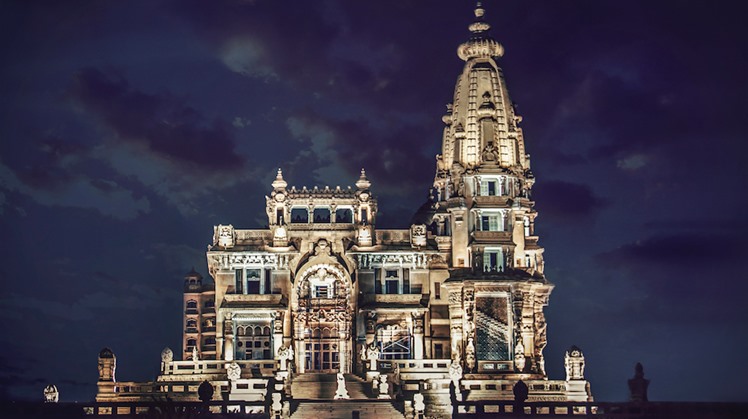Baron Palace is one of the historic palaces in Egypt, which is located in the heart of one of the most prestigious areas in Cairo, Heliopolis, specifically on Al-Oruba Street in Salah Salem, and recently, Dr. Khaled Al-Anani, Minister of Tourism and Antiquities, announced the opening of 9 archaeological sites during the next two months, including the Baron Palace Therefore, we review through the next lines the history of this palace and what was done during the period of restoration and development.
The Baron Palace has a style inspired by Indian architecture, constructed by the Belgian millionaire Baron Edward Empain, "September 20, 1852 - July 22, 1929", and the Baron chose the Indian style for the design of the palace as he was living there, and came to Egypt at the end of the nineteenth century shortly after the opening The Suez Canal, and Edward Empain held the title of Barron and was awarded to him by the King of France in appreciation of his efforts to establish the Paris metro.
Once Imban arrived in Egypt, he loved her to the point of madness and made a fateful decision to remain in it until his death, to the point that he recommended that he be buried even if he died outside of it, and from his love and love for Egypt he decided to build his residence there, so the Baron chose a place in the desert, near Cairo, to build the Baron Palace .
Indeed, the Baron offered the Egyptian government to establish a whole neighborhood in East Cairo, and chose a name for it, which is Heliopolis, the city of the sun, and the Baron bought acres for only one pound, as the region lacked the facilities, transportation, and services.
The Baron wanted to attract people to live in the new neighborhood, so he created a metro and took the name of the city the Heliopolis metro, as he commissioned the Belgian engineer André Brasilo who was working at that time with the Paris metro company to create a metro line linking the neighborhood or the new city to Cairo.
As for the palace, he decided to be legendary from the sun, as he entered it from all his rooms, and he became the most luxurious palaces in Egypt at all, and he drew his idea from the Anchor Wat temple in Cambodia and the Hindu temples of Orissa, designed by the French architect Alexander Marcel and decorated by George Louis Claude, as a balcony. The outer palace is decorated with statues of Indian elephants, and the windows rise and fall with Indian and Buddhist statues.
The palace, which was completed in 1911 AD, is an interior of a small size, it does not exceed two floors and contains only 7 rooms. The first floor is a large hall and three rooms, 2 of which are for hospitality, and the third was used by Baron Empain as a hall for playing billiards, while the upper floor consists of 4 rooms for sleeping and each bathroom is attached to it. The floor of the palace is covered with marble and parquet, while the basement (basement) used to have kitchens, garages, and servants' rooms.
As for what has been accomplished in the palace, the process of restoring the palace began under the supervision of the Engineering Authority of the Armed Forces as the structural reinforcement of the palace roofs and restoration and finishing of the facades and cleaning and restoration of the decorative elements in it, completing the deficiencies of the doors and windows, and the completion of cleaning and restoration of marble columns and wooden doors and metal windows And the restoration of ornate iron windows on the main facades and the wall panel above the main entrance, and the marble statues at the public site, indicating that work has begun to raise the efficiency of the general site of the palace and coordinate its garden.
Brigadier Hisham Samir, assistant minister of antiquities for engineering affairs and supervisor of the historic Cairo project, said that the work inside and outside the Baron Palace has completely ended, with the latest internationally recognized scientific methods, and are ready to open it at any time, as the project costed more than 100 million pounds.
Brigadier Hisham Samir said that there are some works that have been added to the public site, such as completing the fences and developing the back garden, which will be implemented at 100% during the current month.
The show inside the palace tells the history of the Heliopolis neighborhood to include a variety of photos, archival documents, illustrations, maps, and addresses for the history of Heliopolis neighborhood (Heliopolis and Mataria) through different eras, in addition to its most important heritage features, and a variety of pictures, maps, documents and films that tell the history of Heliopolis and aspects And the lifestyle in that special time period.
And the price of entry tickets to the palace will be accessible to all, and it will be 100 pounds for the foreigner and 50 for the foreign student, and for the Egyptians 20 pounds and 10 for students, in addition to that all Egyptians over 60 years of the visit are free.
 Mon, Jun. 15, 2020
Mon, Jun. 15, 2020